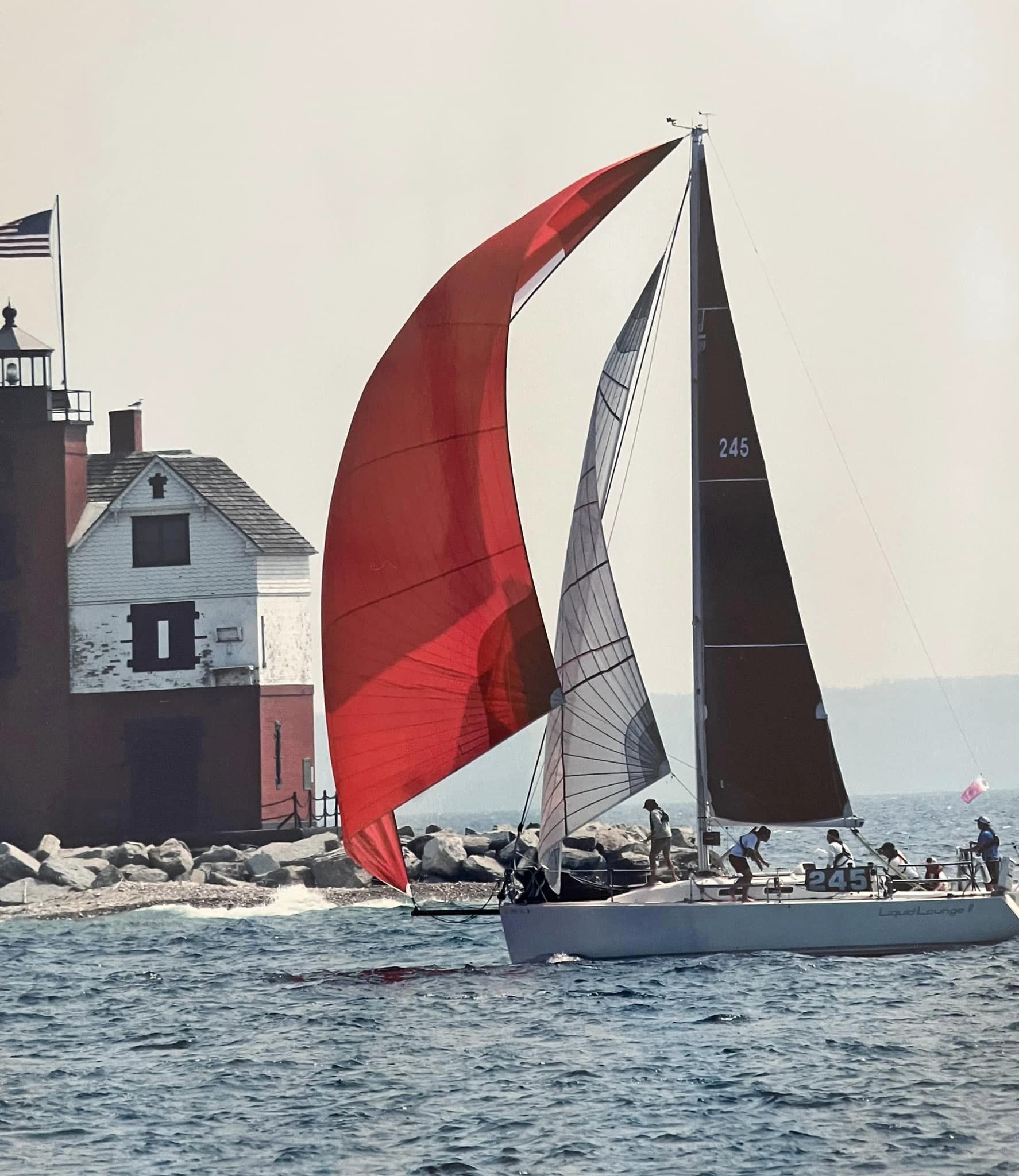Finding the right set up to get the most out of your boat
By Andy Camarda, edited by Carl Eaton
To anybody unfamiliar with the sport of sailing, it would seem preposterous that the margin between competitors is measured in minutes and seconds at the end of a 333-mile race. It is even more unbelievable if you consider that most teams are sailing boats of various lengths, designs, and rig plans. As competitors, we are lucky to have access to a comprehensive rating system able to level the playing field between a Tartan 10 and a TP52. In 2021, the Chicago Yacht Club’s Race to Mackinac committee made the decision to switch to the ORC rating system for all competitors in the race. It goes without saying that optimizing for ORC can make all the difference. After all, the winner can be decided by a single second. Racing under ORC can seem awfully ambiguous compared to one-design. Every boat is different, therefore different adjustments must be made to perform up-to-par under ORC, but there are a few key items that every team needs to consider to find success.
Before we dive into the specifics of optimization, its important to understand how ORC works as a rating formula. As opposed to PHRF where the rating is derived from the observed performance of a boat, ORC is built from the theoretical speed of a boat based on a slew of measurements, everything from crew weight to the stability. The formula output from these measurements is known as the Velocity Prediction Program or VPP. The VPP assembles a table with wind speed and angle on each axis. From here, boat speeds are calculated for each configuration, which are then translated into ratings. The average ratings from different “wind mixes” are used to create an infinite number of ratings that can be adjusted for different styles of racing (Offshore vs Inshore) and courses (Fastnet vs Chicago Mac). For the Chicago to Mackinac race, the organizers have selected three “wind mixes” based off the typical prevailing conditions on Lake Michigan which can be selected for use. This means that ratings will change depending on which “wind mix” the committee pre-selects for the race based off the forecast. The wind mixes for the Chicago Mackinac Race among others can be found on US Sailing’s site here.
So there we have it─ every boat has a rating assigned by a computer and there is nothing you can do about it… good luck! Unfortunately, some people believe this to be true, but trust me when I say that we’re just getting started. Buckle up, because now it’s time to optimize. When I say optimize, I mean that we are simply trying to make the boat go faster relative to its rating in the conditions we expect to see. Fortunately, we don’t have to guess since anyone can go to ORC.org and create test certificates for any boat in the database. With some old-fashioned trial and error, you can play around with everything from sail area, to rig dimensions, to crew weight and see how they affect your boat’s rating. It’s important to consider the rating based on the conditions you expect to see in your locale. On the Great Lakes, optimization for light air performance would be the priority. A boat that is set up correctly for its preferred conditions can out-perform the VPP. This is the essence of optimization.
The standard conditions for a Chicago to Mackinac Race can be difficult to pinpoint, and I’m sure there will be some differing opinions. In my experience, a light air, mostly downwind race is what I’d expect to see. Under this assumption, the first box to check would be to make sure the boat has enough power to get downwind in those light to medium conditions. On modern boats, spinnaker sizing is a delicate balance, as the VPP can predict that the boat will plane at a lower wind speed and greatly affect the rating in certain wind mixes. On most racer-cruisers, especially older models with symmetrical spinnakers, increasing spinnaker area to keep the speed up as the wind dies is crucial. Retro-fitting a masthead kite on a fractional rig or increasing the pole length helps get a more favorable sail-area to displacement ratio. Generally speaking, maximizing the hoist or pole length will not dramatically affect a boat’s rating while allowing more room for staysails which do not incur any rating penalty whatsoever.

You heard me right, staysails are free! Under most rating systems, “conforming staysails” are not seen as additional sail area, and ORC is no exception. Carrying a staysail or two is a no brainer. Just like any other sail, staysails can be purpose-built for specific wind angles and sail configurations. A “spinnaker staysail” is typically set flying behind the forestay to complement a downwind sail with the wind aft of the beam. These sails can be as much as 20-30% of the spinnaker area and can add considerable speed in the right conditions. Another option is a “genoa staysail,” but don’t be fooled by the name, since most boats carry jibs instead of genoas these days. A genoa staysail has a flatter cut and is more commonly set inside of a code zero or reaching spinnakers to add more sail area while sailing tight angles. Even though these staysails are used for different purposes, their respective wind ranges can overlap. With the right halyards, tack points, and sheeting angles, both staysails can be set at the same time inside of a code zero or spinnaker in certain conditions. With this configuration, you’re almost guaranteed to outperform the VPP rating.

Over the last decade, the modern code zero has completely changed how we race. While they are certainly not free under ORC like staysails, they can be purpose-built for different wind speeds and angles. Code zeros are unique in the variety of conditions they can be built to handle, so ORC accounts for them in a distinct manner. As opposed to spinnakers and headsails, where only the largest in each category is taken into account, every code zero in the inventory will show up on an ORC certificate. The key measurement taking precedence in how your rating will change is the mid-girth. In ORC, a code zero is classified as any sail set flying in front of the forestay with a mid-girth less than 85% of the foot-length. Code zeros are the most useful tool to address a weakness in a boat’s performance. For example, boats with fractional jibs tend to struggle on a close reach in light-air. A small, upwind-oriented code zero with a small mid-girth will help the boat’s performance greatly in those conditions while only incurring a relatively small rating penalty. Boats carrying a genoa are better suited to carry a larger code zero to improve reaching and broad reaching performance. Code zeros with a smaller mid-girth to foot ratio will be more efficient at tighter angles but are subject to a larger rating penalty.
While the minutia of sail measurements add up and may slightly affect a boat’s rating, let’s consider the big picture. Optimizing your inventory as a whole has a much greater affect than any individual sail. Keep in mind that crossover between sails is by no means a bad thing. Often times a code zero can be just as effective, if not more effective, than a jib or genoa upwind or a spinnaker on a reach. Sails today are stronger, and therefore more versatile than ever before. Optimizing your inventory means cutting redundancies and patching holes in your sail chart. It’s becoming more common to leave the light jib on the dock and opt for an upwind code zero for a light-air race , or cut down your largest headsail for a better rating and improved performance. Simplifying and streamlining your sail inventory will not only improve your rating, it will also make sailing your boat painless and straightforward for the crew.

But before you go re-cutting your sails, there are two simple things you should check on your certificate to work towards a more favorable rating. The first is to identify whether you have a “fully measured” or “international” certificate. When boats are not officially measured or are lacking the appropriate data, the handicappers are forced to make assumptions about your particular boat, and they will always err on the faster side. Boats tend to gain weight over time with added parts and repairs, so your rating will likely improve once the assumptions are replaced with accurate measurements. The other piece of low hanging fruit is the “racer-cruiser” credit, which is awarded to boats with certain creature comforts like cabin doors and galley equipment. Many boats can achieve a “racer-cruiser” designation with very few additions to the boat. More information can be found here, on page 30.
You might have noticed that optimizing for ORC is less about sailing and more about work on the front end. Charts, formulas, inventories─ it all may seem a bit tedious, but it is undoubtably worth it. After all, you can sail harder than ever before with a good crew and brand-new sails, but if you don’t do the work on the front end to get a favorable rating in place, your hard work may never be rewarded. Sailboat racing is about controlling the controllable, and we know darn well that there is no controlling Lake Michigan. When the lake does work in your favor, give yourself the best chance at getting on the podium by taking advantage of these small, yet effective tweaks to your boat’s performance.
This is the fourth chapter of our Race to Mackinac coverage, you can find our previous editions here:
- Maverick Smashes the Chicago to Mackinac Record – An interview with navigator Rodney Keenan
- A Tale of Two Macs – Setting up two boats, old and new, to win under ORC, Part one, the classic racer cruiser
- A Tale of Two Macs – Setting up two boats, old and new, to win under ORC, Part two the modern French speedster


